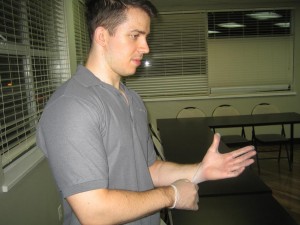Participants enrolled in standard first aid training will learn to recognize and treat a variety of soft tissue injuries. Courses are available in major and minor cities throughout Canada including in Grande Prairie. Soft tissue injuries include contusions (bruises), abrasions, avulsions, lacerations, punctures, amputations, embedded objects and bites. Candidates must apply skills and knowledge learned in previous sections of the course. The information posted on the page is the minimum required components for candidates to successfully complete the soft tissue injury component of the course.
To successfully complete the standard first aid course candidates must do the following when treating victims of soft tissue injury:
- Check the scene for any dangers or hazards.
- Determine the mechanism of injury and / or the history of the emergency.
- Assess the patients level of consciousness.
- Complete the primary assessment.
- Stop the patient from moving around.
Make Sure to Put on Gloves before helping - Place the patient into a appropriate position.
- Reassure the patient and treat for shock.
- Rescuer must use appropriate barrier devices (e.g. gloves).
- Rescuer must complete the secondary assessment and maintain the victims airway and breathing.
For victims of contusions:
- Rescuers should apply ice to the contusion (bruise)
For victims of abrasions, lacerations, avulsions, punctures and bites:
- Rescuer should wash minor wounds with soap and water (or saline if available).
- Rescuers should apply firm and direct pressure to any wound using sterile dressing and bandages if available.
- Patients with punctures or bites should seek medical attention immediately.
For victims of embedded objects:
- If the embedded object is more than superficial the rescuer should leave the object in place, stabilize it and place pressure around the object with clean and sterile dressing.
For victims of amputations:
- Rescuers should apply firm and direct pressure with clean and sterile dressing to the amputated area.
- The amputated part should be sent to the hospital with the patient.
The information posted above is the basic information for candidates to successfully complete the soft tissue injury component of a standard first aid course. Participants enrolled in the course will receive hands on training in rescuing victims of soft tissue injury.
